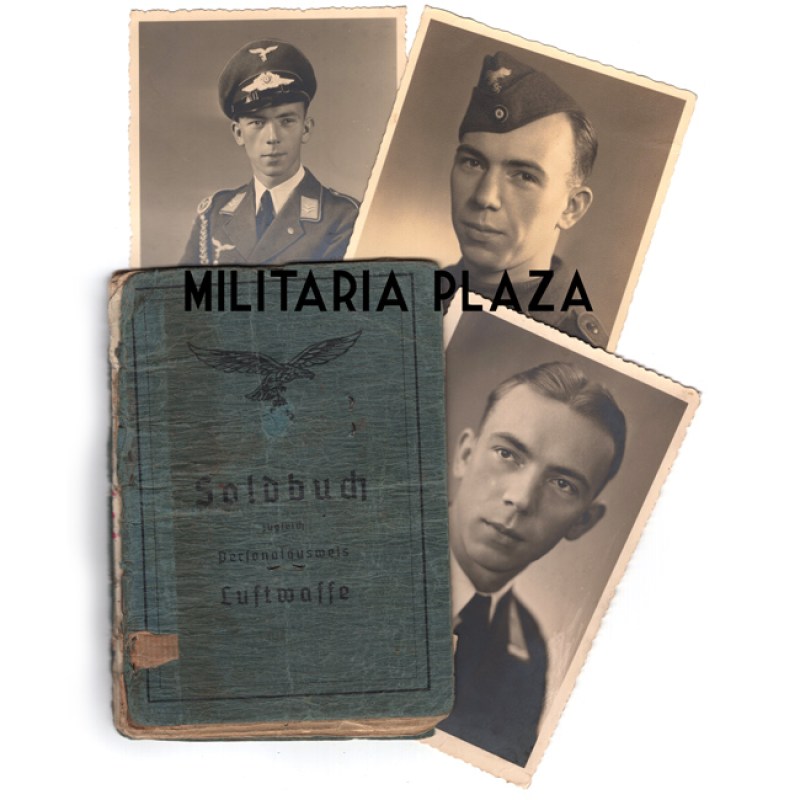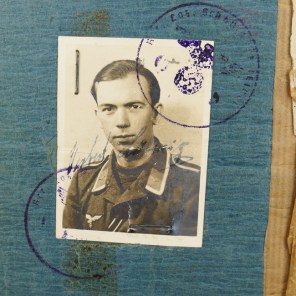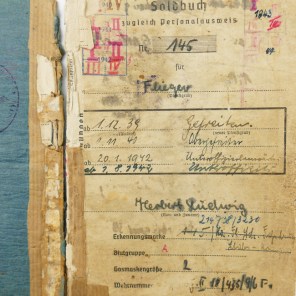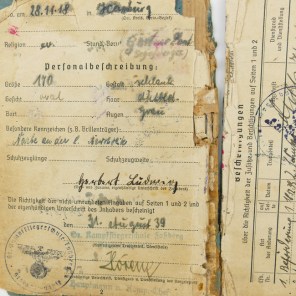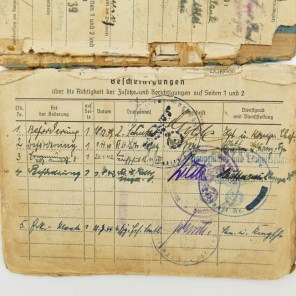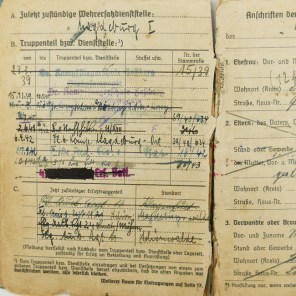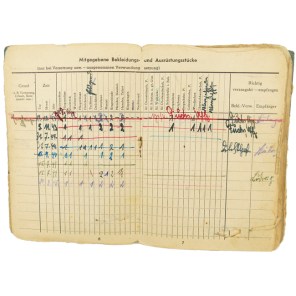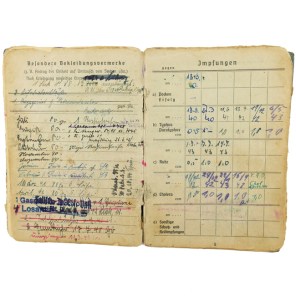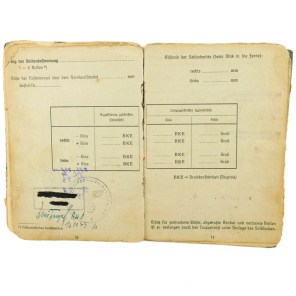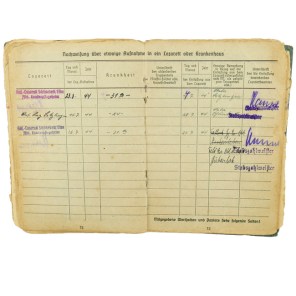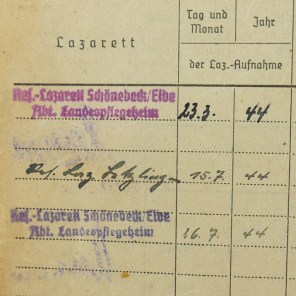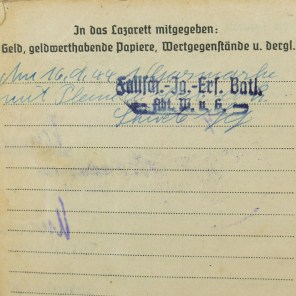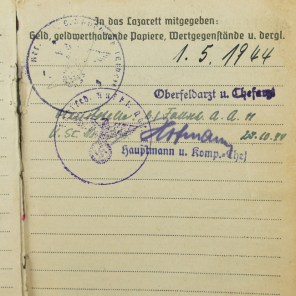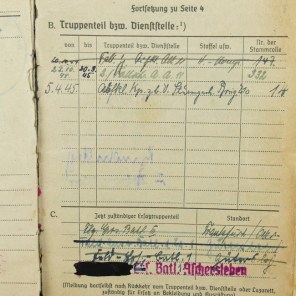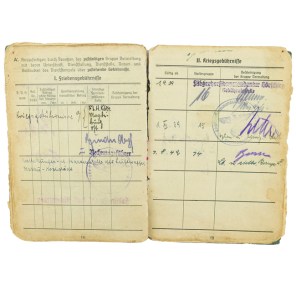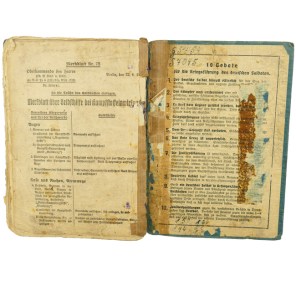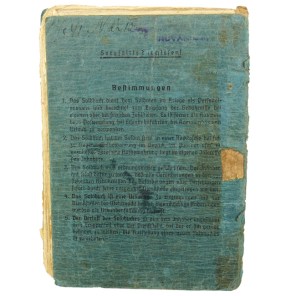Luftwaffe 'Fallschirmjäger' Soldbuch
Luftwaffe 'Fallschirmjäger' Soldbuch with 3 portrait photos which belonged to Unteroffizier 'Herbert Ludwig'. When individuals received their registration notice they were to report to the appropriate recruitment center where they would be issued a 'Wehrpaß', until they were inducted into active duty. From the autumn of 1939, when an individual was inducted into active military service the Wehrpaß was exchanged at the recruitment office for the 'Soldbuch' (Pay Book), which remained in the recipients possession as his official military identification document. The recruitment office would retain the Wehrpass and chronicle the individuals active service record in it.
Herbert Ludwig was born on 28 November 1918 in Hamburg. His Soldbuch was issued on 31 August 1939. The Soldbuch indicates that he served already since March 1939 at the 'Kampffliegerschulde Faßberg' which was a pilot school (also called 'Kampffliegerschule 2') located at the airfield (Fliegerhorst) of Faßberg in Lower Saxony.
From July 1940 until September 1942 he was stationed at the 'Fliegerhorst Magdeburg Ost', a great air base on the banks of the Elbe River, attached to the Luftgaukommando XVII, which apart from the base of fighter and bomber planes, also had other units: flight operations, maintenance and installation, replenishment and supply, air messages (telecommunications), security & air defense.
In September 1942 Herbert was assigned to the II.Bataillon/5.Kompanie of the newly formed 'Luftwaffen Felddivision 1' (Field Division) which was deployed in Russia, attached to the 16.Armee, within Army Group North, fighting in the localities of Novgorod on the shores of Lake Ilmen. The 1st Luftwaffe Field Division maintained defensive positions, throughout 1943, on a relatively calm front. But on 14 January 1944 the Russians launched a major offensive between de Gulf of Finland and the Ilmensee, to liberate Leningrad. The division was caught by surprise, and practically destroyed and the survivors, fought in small Kampfgruppen, fleeing towards the west where they suffered important casualties. Finally, the division was officially dissolved in April 1944. In March, Herbert was wounded by shrapnel and retired from the battle front.
Between July and October 1944, this soldier was stationed in the 'Fallschirm-Jäger-Ersatz-Bataillon 1', a replacement and training paratrooper battailon located in the German town of Aschersleben, near the air base bearing the same name, stationing various other Luftwaffe units.
In October 1944 Herbert was assigned to the 'Fallschirm-Aufklärungs-Abteilung 11', a reconnaissance unit with 4 companies, which was attached to the '1.Fallschirm-Korps', which at that time was fighting in Italy south of Bologna, defending the Vergato/Pianoro line. The front remained calm until in February, the allies launched a great offensive, where the '1. Fallschirm-Korps' had to defend a front too extended, ranging from Monte Calderaro, Monte Grande, Mount Cerere, Imola and north to Lugo, where they suffered significant casualties. The 'Fallschirm-Aufklärungs-Abteilung 11' was reduced to 2 companies with hardly any armoured and reconnaissance vehicles left.
On 16 April 1945 Herbert's last destination was the 'Fallschirm-Sturmgeschütz-Brigade 210', a tank destroyer unit, commanded by the Oberstleutnant 'August Schmitz', this unit was also attached to the '1. Fallschirm-Korps'. This unit that had 3 batteries, with a total of 43 StuG III of 7.5 cm, didn't act as a compact force, but was sent in small groups in support of the infantry, fighting against the US forces around of the Po River. Many of the StuG III of the brigade were destroyed by enemy fire, especially by heavy artillery fire and fighter-bombers; but other armoured vehicles were abandoned due to lack of fuel and spare parts, found intact, by the allies.
On 24 April 1945 four StuG III of the brigade, which provided support service to members of the '4. Fallschirmjäger-Division', in the village of San Giacomo, near the city of Bolzano, participated in a counter-attack. As soon as as they left a small forest, the first StuG III was hit by direct fire from a US tank destroyer, where no member of the crew managed to get out of the burning vehicle. The second was hit in the right chain and on the side, bu the crew was able to escape. A third StuG III was hit on the right side and was inflated, although the fate of its crew is unknown. The fourth StuG III managed to escape without being hit.
The Soldbuch contains numerous entries including delivery of material including a Walther P38, winter camouflage clothing etc, vaccines. Hospitalization entries from March to July 1944 due to the shrapnel wounds Herbert suffered in March 1944, when he served in the 'Luftwaffen Felddivision 1'. Unfortunately some pages in the back of the Soldbuch are missing including his award page, due to his wounds he would at least been awarded a Wound Badge but probably others as well. The booklet is in heavily used condition and a true reflection of his service history. The Soldbuch comes together with 3 portrait photos of Herbert. A truly interesting piece of history!
